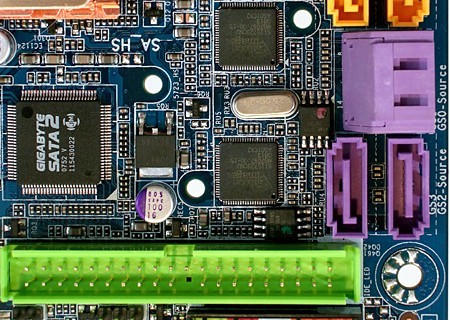11-Way P45 Motherboard Shootout
EP45-DQ6 Onboard Devices
| Northbridge | Intel P45 Express |
| Southbridge | Intel ICH10R |
| Voltage Regulator | Twelve Phases |
| BIOS | F10a (07/16/2008) |
| 333.3 MHz (FSB1333) | 333.4 MHz (+0.02%) |
| Clock Generator | IC2 9LPRS914EKL |
| Connectors and Interfaces | |
| Onboard | 2x PCIe 2.0 x16 (Modes : One x16, One x8) |
| 2x PCIe x4, Open Ended (Accepts x16 Cards) | |
| 1x PCIe x1 | |
| 2x PCI | |
| 2x USB 2.0 (2 ports per connector) | |
| 3x IEEE-1394 FireWire | |
| 1x Serial Port header | |
| 1x Floppy | |
| 1x Ultra ATA (2 drives) | |
| 10x Serial ATA 3.0Gb/s | |
| 1x Front Panel Audio | |
| 1x CD-Audio In | |
| 1x S/P-DIF Out | |
| 2x Fan 4 pins (CPU/System) | |
| 2x Fan 3 pins (Chassis) | |
| 1x Internal Power Button | |
| 1x Internal Reset Button | |
| 1x Internal CLR_CMOS Button | |
| IO panel | 2x PS2 (keyboard + mouse ) |
| 2x Digital Audio Out (S/P-DIF Coaxial, Optical) | |
| 4x RJ-45 Network | |
| 8x USB 2.0 | |
| 6x Analog Audio Jacks (8-ch out, Mic+Line In) | |
| Mass Storage Controllers | |
| Intel ICH10R | 6x SATA 3.0Gb/s (RAID 0,1,5,10) |
| Gigabyte SATA2 (by Jmicron) PCI-E | 1x Ultra ATA-133 (2-drives) |
| 2x SATA Host for SteelVine Controller | |
| 2x Silicon Image Sil5723CNU SATA | 4x SATA 3.0Gb/s (RAID 0, 1, Cascading) |
| Network | |
| 4x Realtek RTL8111B PCI-E | Quad Gigabit LAN with Teaming |
| Audio | |
| Realtek ALC889A HD Audio Codec | 7.1 + 2 channel Multi-Streaming Output |
| Texas Instruments TSB43AB23 PCI | 3x IEEE-1394a (400 Mbit/s) |
Gigabyte uses all six of the ICH10R’s PCI Express lanes for a single x1 slot and five onboard devices.
Gigabyte’s port panel is filled with USB and Gigabit Network connections, but that means it lacks several other key elements such as eSATA and FireWire. Few users will have eight USB 2.0 devices that they want to be plugged into the back, and we’d have preferred to see a couple of these ports moved to a third front-panel header. At least the full set of audio connections is provided, with digital optical and digital coaxial connections, plus enough analog channels to support 7.1 surround output, line-level input, and a stereo microphone simultaneously.
We didn’t mention that the number of internal Serial ATA ports totaled ten on the previous page because four of these are meant to be used with included eSATA breakout cables. Of course they can still be used internally, but the four we speak of now have a couple other things in common. Two Silicon Image SIL5723 “SteelVine” port multipliers connect the four ports to two SATA links supplied by the Gigabyte SATA2 controller. That means that each drive pair relies on a single 3.0 Gb/s link, and that each pair will appear as a single SteelVine drive to the chipset and OS. Furthermore, both SteelVine controllers are limited by the SATA2 controller’s PCI Express x1 interface to only 250MB/s, which is a significant handicap for RAID 0 configurations of more than two drives.
SteelVine controllers have a few additional features, such as drive cascading and hardware RAID 1/0 capability, as we discussed in our technical analysis
Gigabyte uses PCI Express to provide the best possible performance to four Realtek RTL8111C Gigabit Ethernet controllers. The first two are easy to find at the EP45-DQ6’s rear edge.
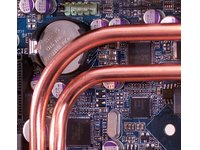
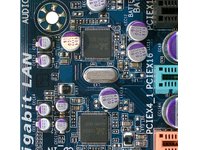
The fourth Gigabit network controller is located beneath the chipset-to-VRM heatpipes. Due to the high number of onboard devices Gigabyte had to get stealthy with the third controller, hiding it beneath the battery ! All four controllers can be combined in teaming mode for network speeds of up to four gigabits per second.
The Texas Instruments TSB43AB23 three-port IEEE-1394 FireWire controller is hidden with a little less stealth beneath the extended portion of the x16 length, x8 mode secondary graphics card slot.
Get Tom's Hardware's best news and in-depth reviews, straight to your inbox.
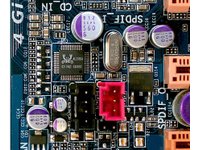
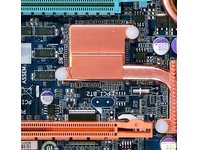
Gigabyte uses the Realtek ALC889A to provide eight channel output (7.1 surround) with separate headphone channels for audio multi-streaming. The codec is rated at an impressive 107db signal-to-noise ratio.
Current page: EP45-DQ6 Onboard Devices
Prev Page Gigabyte GA-EP45-DQ6 Next Page EP45-DQ6 BIOS And Overclocking-
nickchalk Where are the lower price P45 M/B ?Reply
Asus P5Q pro is out for €110 and P5Q deluxe for €165 the price difference is about 70$ in Greece. -
Proximon I suppose I can get some good from having read this. Did you get paid by the word? Maybe next time you could just put together a complete features chart so that we can have some convenient comparison? You know, so someone could go to a chart and see at a glance which boards had eSATA or firewire, or 8 USB.Reply
-
JPForums I'd rather have the overabundance of information than a lack of information. Presentation could use a little refining (I.E. comparison charts and the likes), but having the relevant information available at least is a good thing.Reply -
the introduction and specifics are nice, the comparision isn't. so, why don't you test with an 8500 or qx9650? 6850 are outdated... and a mobo handling a c2d doesn't mean it can handle a quad too, see P5K for example (it stinks when it comes to a q6600).Reply
-
Crashman procithe introduction and specifics are nice, the comparision isn't. so, why don't you test with an 8500 or qx9650? 6850 are outdated... and a mobo handling a c2d doesn't mean it can handle a quad too, see P5K for example (it stinks when it comes to a q6600).Reply
Tom's Hardware wants the performance of current articles to reflect that of recent articles, so a "standard test platform" was chosen a while ago. It will get updated, but probably not before the new socket becomes widely available. -
zenmaster I would have liked to see something such as a P35 and an X48 as controls to help analyze the P45 Performance.Reply
In otherwords, What is the P45 Gaining me over the older P35.
What would I gain by going to the X48. (Or Lose) -
Crashman zenmasterI would have liked to see something such as a P35 and an X48 as controls to help analyze the P45 Performance.In otherwords, What is the P45 Gaining me over the older P35.What would I gain by going to the X48. (Or Lose)http://www.tomshardware.com/reviews/intel-p45-chipset,1961.htmlReply -
johnbilicki The first 17 pages were filled with nothing but junk from ASUS. Do us a favor: don't even bother featuring or *MENTIONING* anything for any reason from a company that refuses to RMA 200-400 dollar brand new motherboards with anything other then used and usually broken junk. It destroyed my enthusiasm for the article.Reply -
dobby nickchalkWhere are the lower price P45 M/B ?Asus P5Q pro is out for €110 and P5Q deluxe for €165 the price difference is about 70$ in Greece.Reply
the p5q PRo is a p43 board, i should know i have one

